Solutions for Image Processing for Engineers by Yagle and Ulaby
- 1. Problem 1.1 An imaging lens in a digital camera has a focal length of 6 cm. How far should the lens be from the cameraÔÇÖs CCD array to focus on an object (a) 12 cm in front of the lens? (b) 15 cm in front of the lens? Solution: (a) The lens equation (Eq. (1.1)) is 1 do + 1 di = 1 f . Here, f = 6 cm and do = 12 cm, so di = 12 cm . (b) The lens equation (Eq. (1.1)) is 1 do + 1 di = 1 f . Here, f = 6 cm and do = 15 cm, so di = 10 cm . Contact me in order to access the whole complete document. WhatsApp: https://wa.me/message/2H3BV2L5TTSUF1 Email: smtb98@gmail.com Telegram: https://t.me/solutionmanual s m t b 9 8 @ g m a i l . c o m s m t b 9 8 @ g m a i l . c o m complete document is available on https://unihelp.xyz/ *** contact me if site not loaded
- 2. Problem 1.2 An imaging lens in a digital camera has a focal length of 4 cm. How far should the lens be from the cameraÔÇÖs CCD array to focus on an object (a) 12 cm in front of the lens; (b) 8 cm in front of the lens. Solution: (a) The lens equation (Eq. (1.1)) is 1 do + 1 di = 1 f . Here, f = 4 cm and do = 12 cm, so di = 6 cm . (b) The lens equation (Eq. (1.1)) is 1 do + 1 di = 1 f . Here, f = 4 cm and do = 8 cm, so di = 8 cm .
- 3. Problem 1.3 The following program loads an image stored in clown.mat as Io(x, y), passes it through an imaging system with the PSF given by Eq. (1.6), and displays Io(x, y) and Ii(x, y). Parameters Ôêå, D, di, and ╬╗ (all in mm) are specified in the programÔÇÖs first line. clear;Delta=0.0002;D=0.03;lambda=0.0000005;di=0.003;T=round(0.01/Delta); for I=1:T;for J=1:T;x2y2(I,J)=(I-T/2).*(I-T/2)+(J-T/2).*(J-T/2);end;end; gamma=pi*D/lambda*sqrt(x2y2./(x2y2+di*di/Delta/Delta)); h=2*besselj(1,gamma)./gamma; h(T/2,T/2)=(h(T/2+1,T/2)+h(T/2-1,T/2)+h(T/2,T/2+1)+h(T/2,T/2-1))/4; h=h.*h;H=h(T/2-5:T/2+5,T/2-5:T/2+5);load clown.mat;Y=conv2(X,H); figure,imagesc(X),axis off,colormap(gray),figure,imagesc(Y),axis off,colormap(gray) Run the program and display Io(x, y) (input) and Ii(x, y) (output). Solution: Io(x, y) is at left and Ii(x, y) is at right. The image formed by the optical system is blurred, as expected.
- 4. Problem 1.4 Compare the azimuth resolution of a real-aperture radar with that of a synthetic- aperture radar, with both pointed at the ground from an aircraft at a range R = 5 km. Both systems operate at ╬╗ = 3 cm and utilize a 2-m-long antenna. Solution: For the real-aperture radar, ÔêåY ÔÇ▓ min = ╬╗R ly = 3 ├ù 10ÔêÆ2 ├ù 5 ├ù 103 2 = 75 m. For the SAR, ÔêåY ÔÇ▓ min = ly 2 = 2 2 = 1 m.
- 5. Problem 1.5 A 2-m-long antenna is used to form a synthetic-aperture radar from a range of 100 km. What is the length of the synthetic aperture? Solution: Scaling the range in Fig. 1-21 from 400 km down to 100 km leads to a synthetic aperture shorter by the same factor. Hence, the synthetic aperture is of length 8 km/4 = 2 km.
- 6. Problem 1.6 The following program loads an image stored in sar.mat as Io(x, y), passes it through an imaging system with the PSF given by Eq. (1.15), and displays Io(x, y) and Ii(x, y). Parameters Ôêå, ¤ä, and l are specified in the programÔÇÖs first line. clear;Delta=0.1;l=5;tau=1;I=[-15:15];z=pi*1.8*Delta*I/l;load sar.mat; hy=sin(pi*z)./(pi*z);hy(16)=1;hy=hy.*hy;hx=exp(-2.77*Delta*Delta*I.*I/tau/tau); H=hyÔÇÖ*hx;Y=conv2(X,H); figure,imagesc(X),axis off,colormap(gray),figure,imagesc(Y),axis off,colormap(gray) Run the program and display Io(x, y) (input) and Ii(x, y) (output). Solution: Io(x, y) is at left and Ii(x, y) is at right. The image formed by the radar system is blurred, as expected.
- 7. Problem 1.7 (This problem assumes prior knowledge of the 1-D Fourier transform (FT)). The basic CT problem is to reconstruct ╬▒(╬¥, ╬À) in Eq. (1.18) from p(r, ╬©). One way to do this is as follows: (a) Take the FT of Eq. (1.18), transforming r to f. Define p(ÔêÆr, ╬©) = p(r, ╬© + ¤Ç). (b) Define and substitute ┬Á = f cos ╬© and ╬¢ = f sin ╬© in this FT. (c) Show that the result defines 2 FTs, transforming ╬¥ to ┬Á and ╬À to ╬¢, and that A(┬Á, ╬¢) = P(f, ╬©). Hence, ╬▒(╬¥, ╬À) is the inverse FT of P(f, ╬©). Solution: (a) The FT of Eq. (1.18) taking r to f is P(f, ╬©) = F F F{p(r, ╬©)} = Z Ôê× ÔêÆÔê× Z Ôê× ÔêÆÔê× ╬▒(╬¥, ╬À) eÔêÆj2¤Çf(╬¥ cos ╬©+╬À sin ╬©) d╬¥ d╬À. (b) Substituting gives P(f, ╬©) = Z Ôê× ÔêÆÔê× Z Ôê× ÔêÆÔê× ╬▒(╬¥, ╬À) eÔêÆj2¤Ç┬Á╬¥ eÔêÆj2¤Ç╬¢╬À d╬¥ d╬À. (c) P(f, ╬©) = F F F╬¥ÔåÆ┬Á{F F F╬ÀÔåÆ╬¢{╬▒(╬¥, ╬À)}} = A(┬Á, ╬¢),
- 8. Problem 1.8 The following program loads an image stored in mri.mat as Io(x, y), passes it through an imaging system with the PSF given by Eq. (1.20), and displays Io(x, y) and Ii(x, y). Parameters Ôêå, N, and dk are specified in the programÔÇÖs first line. clear;N=16;Delta=0.01;dk=1;I=[-60:60];load mri.mat; h=dk*sin(pi*N*dk*I*Delta)./sin(pi*dk*I*Delta);h(61)=N;H=hÔÇÖ*h;Y=conv2(X,H); figure,imagesc(X),axis off,colormap(gray),figure,imagesc(Y),axis off,colormap(gray) Run the program and display Io(x, y) (input) and Ii(x, y) (output). Solution: Io(x, y) is at left and Ii(x, y) is at right. The image formed by the MRI system is blurred, as expected.
- 9. Problem 1.9 This problem shows how beamforming works on a linear array of transducers, as illustrated in Fig. 1-35, in a medium with a wave speed of 1540 m/s. We are given a linear array of transducers located 1.54 cm apart along the x axis, with the nth transducer located at x = 1.54n cm. Outputs {yn(t)} from the transducers are delayed and summed to produce the signal y(t) = P n yn(t ÔêÆ0.05n). In what direction (angle from perpendicular to the array) is the array focused? Solution: Consider a plane wave (impulse in space and time) ╬┤(t ÔêÆ x sin ╬© ÔêÆ y cos ╬©) arriving at the array from a direction ╬© (angle from perpendicular to the array). The plane wave hits the nth transducer at t = n sin(╬©) 1.54 cm 1540 m/s = 0.1n sin ╬©. Setting the delay between tranducers 0.05n = 0.1n sin ╬© gives ╬© = 30Ôùª .
- 10. Problem 2.1 Compute the following convolutions: (a) eÔêÆt u(t) Ôêù eÔêÆ2t u(t) (b) eÔêÆ2t u(t) Ôêù eÔêÆ3t u(t) (c) eÔêÆ3t u(t) Ôêù eÔêÆ3t u(t) Solution: The convolution of two causal signals is y(t) = u(t) R t 0 h(¤ä) x(t ÔêÆ ¤ä) d¤ä. (a): eÔêÆt u(t) Ôêù eÔêÆ2t u(t) = u(t) R t 0 eÔêƤä eÔêÆ2(tÔêƤä) d¤ä = eÔêÆ2t u(t) R t 0 e¤ä d¤ä = eÔêÆ2t u(t) [et ÔêÆ 1] = eÔêÆt u(t) ÔêÆ eÔêÆ2t u(t) (b): eÔêÆ2t u(t) Ôêù eÔêÆ3t u(t) = u(t) R t 0 eÔêÆ2¤ä eÔêÆ3(tÔêƤä) d¤ä = eÔêÆ3t u(t) R t 0 e¤ä d¤ä = eÔêÆ3t u(t) [et ÔêÆ 1] = eÔêÆ2t u(t) ÔêÆ eÔêÆ3t u(t) (c): eÔêÆ3t u(t) Ôêù eÔêÆ3t u(t) = u(t) R t 0 eÔêÆ3¤ä eÔêÆ3(tÔêƤä) d¤ä = eÔêÆ3t u(t) R t 0 d¤ä = teÔêÆ3t u(t)
- 11. Problem 2.2 Show that the spectrum of sin(20¤Çt) ¤Çt sin(10¤Çt) ¤Çt is zero for |f| > 15 Hz. Solution: Using the Fourier transform property F[x(t)y(t)] = X(f) Ôêù Y(f), and the property that the width of a convolution is the sum of the widths, the bandwidth of the product of two signals is the sum of their bandwidths. F sin(20¤Çt) ¤Çt = 1, |f| 10 Hz 0, |f| 10 Hz and F sin(10¤Çt) ¤Çt = 1, |f| 5 Hz 0, |f| 5 Hz. Hence, F sin(20¤Çt) ¤Çt sin(10¤Çt) ¤Çt = 0 for |f| 15 Hz.
- 12. Problem 2.3 Using only Fourier transform properties, show that sin(10¤Çt) ¤Çt [1 + 2 cos(20¤Çt)] = sin(30¤Çt) ¤Çt . Solution: F h sin(10¤Çt) ¤Çt i = 1, |f| 5 0, |f| 5 Using the modulation property: F[x(t) cos(2¤Çf0t)] = 1 2 X(f ÔêÆ f0) + 1 2 X(f + f0), we have F sin(10¤Çt) ¤Çt cos(20¤Çt) = 1 2, 5 Hz |f| 15 Hz, 0, otherwise. Adding the first equation to double the second equation gives F sin(10¤Çt) ¤Çt (1 + 2 cos(20¤Çt)) = 1, |f| 5 Hz 0, |f| 5 Hz + 1, 5 Hz |f| 15 Hz, 0, otherwise = 1, |f| 15 Hz, 0, |f| 15 Hz. The inverse Fourier transform of this result is sin(30¤Çt) ¤Çt . The sum of this lowpass filter and bandpass filter is another lowpass filter: - f (Hz) ÔÇô15 ÔÇô5 5 15
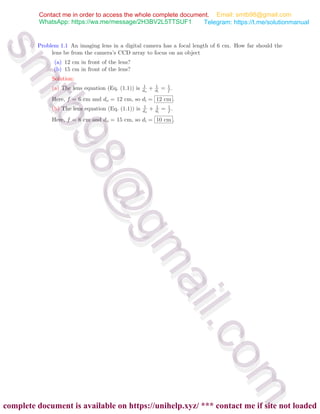
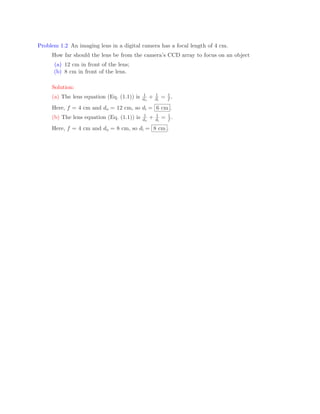
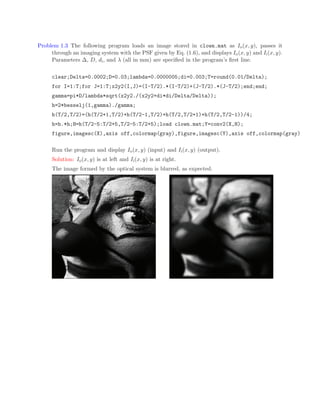
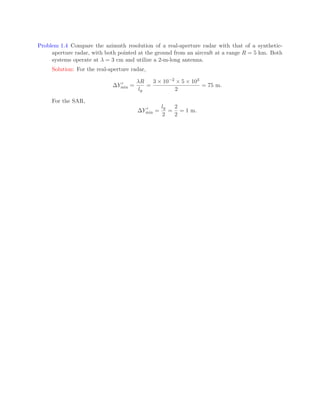

![Problem 1.6 The following program loads an image stored in sar.mat as Io(x, y), passes it through
an imaging system with the PSF given by Eq. (1.15), and displays Io(x, y) and Ii(x, y).
Parameters Ôêå, ¤ä, and l are specified in the programÔÇÖs first line.
clear;Delta=0.1;l=5;tau=1;I=[-15:15];z=pi*1.8*Delta*I/l;load sar.mat;
hy=sin(pi*z)./(pi*z);hy(16)=1;hy=hy.*hy;hx=exp(-2.77*Delta*Delta*I.*I/tau/tau);
H=hyÔÇÖ*hx;Y=conv2(X,H);
figure,imagesc(X),axis off,colormap(gray),figure,imagesc(Y),axis off,colormap(gray)
Run the program and display Io(x, y) (input) and Ii(x, y) (output).
Solution: Io(x, y) is at left and Ii(x, y) is at right.
The image formed by the radar system is blurred, as expected.](https://image.slidesharecdn.com/solutionmanualforimageprocessingforengineersbyyagleandulaby-241119044652-3b970eb6/85/Solutions-for-Image-Processing-for-Engineers-by-Yagle-and-Ulaby-6-320.jpg)

![Problem 1.8 The following program loads an image stored in mri.mat as Io(x, y), passes it through
an imaging system with the PSF given by Eq. (1.20), and displays Io(x, y) and Ii(x, y).
Parameters Ôêå, N, and dk are specified in the programÔÇÖs first line.
clear;N=16;Delta=0.01;dk=1;I=[-60:60];load mri.mat;
h=dk*sin(pi*N*dk*I*Delta)./sin(pi*dk*I*Delta);h(61)=N;H=hÔÇÖ*h;Y=conv2(X,H);
figure,imagesc(X),axis off,colormap(gray),figure,imagesc(Y),axis off,colormap(gray)
Run the program and display Io(x, y) (input) and Ii(x, y) (output).
Solution: Io(x, y) is at left and Ii(x, y) is at right.
The image formed by the MRI system is blurred, as expected.](https://image.slidesharecdn.com/solutionmanualforimageprocessingforengineersbyyagleandulaby-241119044652-3b970eb6/85/Solutions-for-Image-Processing-for-Engineers-by-Yagle-and-Ulaby-8-320.jpg)
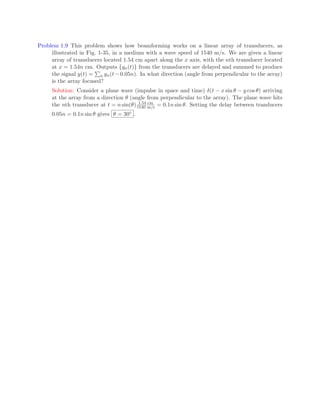
![Problem 2.1 Compute the following convolutions:
(a) et u(t)  e2t u(t)
(b) e2t u(t)  e3t u(t)
(c) e3t u(t)  e3t u(t)
Solution:
The convolution of two causal signals is y(t) = u(t)
R t
0 h(¤ä) x(t ÔêÆ ¤ä) d¤ä.
(a): et u(t)  e2t u(t) = u(t)
R t
0 eÔêƤä eÔêÆ2(tÔêƤä) d¤ä = eÔêÆ2t u(t)
R t
0 e¤ä d¤ä = eÔêÆ2t u(t) [et ÔêÆ 1] =
et u(t)  e2t u(t)
(b): e2t u(t)  e3t u(t) = u(t)
R t
0 eÔêÆ2¤ä eÔêÆ3(tÔêƤä) d¤ä = eÔêÆ3t u(t)
R t
0 e¤ä d¤ä = eÔêÆ3t u(t) [et ÔêÆ 1] =
e2t u(t)  e3t u(t)
(c): e3t u(t)  e3t u(t) = u(t)
R t
0 eÔêÆ3¤ä eÔêÆ3(tÔêƤä) d¤ä = eÔêÆ3t u(t)
R t
0 d¤ä = teÔêÆ3t u(t)](https://image.slidesharecdn.com/solutionmanualforimageprocessingforengineersbyyagleandulaby-241119044652-3b970eb6/85/Solutions-for-Image-Processing-for-Engineers-by-Yagle-and-Ulaby-10-320.jpg)
![Problem 2.2 Show that the spectrum of sin(20¤Çt)
¤Çt
sin(10¤Çt)
¤Çt is zero for |f| > 15 Hz.
Solution:
Using the Fourier transform property F[x(t)y(t)] = X(f) Ôêù Y(f),
and the property that the width of a convolution is the sum of the widths,
the bandwidth of the product of two signals is the sum of their bandwidths.
F
sin(20¤Çt)
¤Çt
=
1, |f| 10 Hz
0, |f| 10 Hz
and
F
sin(10¤Çt)
¤Çt
=
1, |f| 5 Hz
0, |f| 5 Hz.
Hence,
F
sin(20¤Çt)
¤Çt
sin(10¤Çt)
¤Çt
= 0 for |f| 15 Hz.](https://image.slidesharecdn.com/solutionmanualforimageprocessingforengineersbyyagleandulaby-241119044652-3b970eb6/85/Solutions-for-Image-Processing-for-Engineers-by-Yagle-and-Ulaby-11-320.jpg)
![Problem 2.3 Using only Fourier transform properties, show that
sin(10¤Çt)
¤Çt
[1 + 2 cos(20¤Çt)] =
sin(30¤Çt)
¤Çt
.
Solution:
F
h
sin(10¤Çt)
¤Çt
i
=
1, |f| 5
0, |f| 5
Using the modulation property:
F[x(t) cos(2¤Çf0t)] =
1
2
X(f  f0) +
1
2
X(f + f0),
we have
F
sin(10¤Çt)
¤Çt
cos(20¤Çt)
=
1
2, 5 Hz |f| 15 Hz,
0, otherwise.
Adding the first equation to double the second equation gives
F
sin(10¤Çt)
¤Çt
(1 + 2 cos(20¤Çt))
=
1, |f| 5 Hz
0, |f| 5 Hz
+
1, 5 Hz |f| 15 Hz,
0, otherwise
=
1, |f| 15 Hz,
0, |f| 15 Hz.
The inverse Fourier transform of this result is sin(30¤Çt)
¤Çt .
The sum of this lowpass filter and bandpass filter is another lowpass filter:
- f (Hz)
ÔÇô15 ÔÇô5 5 15](https://image.slidesharecdn.com/solutionmanualforimageprocessingforengineersbyyagleandulaby-241119044652-3b970eb6/85/Solutions-for-Image-Processing-for-Engineers-by-Yagle-and-Ulaby-12-320.jpg)